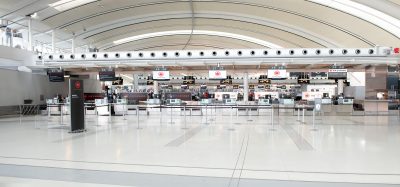Final Call: Kjeld Binger
- Like
- Digg
- Del
- Tumblr
- VKontakte
- Buffer
- Love This
- Odnoklassniki
- Meneame
- Blogger
- Amazon
- Yahoo Mail
- Gmail
- AOL
- Newsvine
- HackerNews
- Evernote
- MySpace
- Mail.ru
- Viadeo
- Line
- Comments
- Yummly
- SMS
- Viber
- Telegram
- Subscribe
- Skype
- Facebook Messenger
- Kakao
- LiveJournal
- Yammer
- Edgar
- Fintel
- Mix
- Instapaper
- Copy Link
Posted: 1 August 2012 | Mark Glover, Commissioning Editor, International Airport Review | No comments yet
In the first of a new series that profiles key individuals from the airport world, Mark Glover from International Airport Review spoke to Kjeld Binger, CEO of Airport International Group (AIG) about the new terminal at the Queen Alia International Airport in Jordan and the role that cargo plays in their operations.
Mark Glover: How important will the new terminal be to the Queen Alia International Airport?
Kjeld Binger: The Queen Alia International Airport (QAIA) is the primary gateway to Jordan and the first and last point of contact for all visitors to the Kingdom; for that reason, AIG is investing approximately USD 750 million in constructing a new state-of-the-art passenger terminal and has invested USD 100 million in a comprehensive upgrade of the current facilities, with the overall objective to position Jordan as a regional niche hub and secure a positive international reputation for the country.
Regular airlines using the QAIA increased from 28 in 2007 to 35 as of June 2012, while both aircraft movements and passenger traffic to and from Amman have increased by approximately 42 per cent, and on average recorded over 1,220 flights.
In the first of a new series that profiles key individuals from the airport world, Mark Glover from International Airport Review spoke to Kjeld Binger, CEO of Airport International Group (AIG) about the new terminal at the Queen Alia International Airport in Jordan and the role that cargo plays in their operations.
Mark Glover: How important will the new terminal be to the Queen Alia International Airport?
Kjeld Binger: The Queen Alia International Airport (QAIA) is the primary gateway to Jordan and the first and last point of contact for all visitors to the Kingdom; for that reason, AIG is investing approximately USD 750 million in constructing a new state-of-the-art passenger terminal and has invested USD 100 million in a comprehensive upgrade of the current facilities, with the overall objective to position Jordan as a regional niche hub and secure a positive international reputation for the country.
Regular airlines using the QAIA increased from 28 in 2007 to 35 as of June 2012, while both aircraft movements and passenger traffic to and from Amman have increased by approximately 42 per cent, and on average recorded over 1,220 flights. Since the beginning of 2012, QAIA has been registering new traffic records each month. In June 2012, passenger traffic exceeded 600,000 and reached up to 619,615 passengers, a 23.78 per cent growth compared to 500,562 passengers during June in 2011. In terms of yearon- year figures, passenger traffic in June exceeded three million, a remarkable 21.97 per cent increase compared to 2,478,950 passengers during the same period in 2011.
We are focusing all of our efforts into building a new terminal that will be a national landmark and source of pride for all Jordanians. There is no compromising when it comes to the structural quality and the installation of the complex machinery in a modern airport. Such mega projects require meticulous and thorough planning and execution, taking into consideration strict technical and architectural criteria, to ultimately deliver a facility in line with quality international standards and to ensure that the final result meets the expectations of all stakeholders.
MG: How will this construction process effect your normal day-to-day airport operations?
KB: The existing two terminals have been able to operate normally while construction on the stateof- the-art new terminal takes place at an adjacent site. Whilst the construction activities have required changing the path of several roads for incoming and outgoing vehicles, overall, the day-to-day operations at the airport have not been affected at all.
MG: How important is the revenue from cargo and how do you plan to make sure it continues to grow?
KB: In the area of air cargo, Jordan has benefited from its geographical position. Air cargo volume in Jordan has experienced growth as a result of the on-going social and political unrest in the region. We are seeing the Kingdom emerge as an important transport and logistics hub for the Levant, due largely, to its safe and stable air, sea and road transportation infrastructure.
At AIG, incorporating advanced cargohandling mechanisms at our new terminal was a priority. Therefore, a cargo strategy study was conducted and several recommendations were made to further develop our cargo potential, including our capacity to handle larger volumes of cargo more efficiently. We will be incorporating improved ramp services and design features that enable efficient ‘tail-to-tail’ cargo transfers, and support infrastructure such as freight forwarders, established trucking and logistics companies and warehouses.
MG: Do you feel that the airport improvements will encourage further airlines to use your facilities?
KB: Since 2007, AIG has had much success when attracting new airlines. The new terminal’s modern facilities will be appealing for airlines looking to expand their networks. We also anticipate a growth in tourism and general interest in Jordan. Furthermore, Jordan has signed bi-lateral ‘open skies’ agreements with 31 countries – including the EU – which will enable us to further capitalise on the terminal opening.
MG: How do you plan to maintain security standards?
KB: Since assuming responsibility for QAIA, AIG has been working hand-in-hand with all government security agencies operating at the airport to ensure that all comprehensive security procedures are in place. The new terminal will be equipped with the most up-to-date security systems to ensure the safety of our visitors and employees, and we look forward to continuing our close relationship with the Jordanian security agencies.
MG: How will the new terminal affect passenger flow at the airport?
KB: Considerable planning and effort was invested in the design of the new terminal to ensure the best quality and satisfaction for visitors. Open spaces, a variety of retail options, and high-quality facilities were key priorities. In terms of the passenger traffic flow inside the terminal, the new building is intuitively designed to allow passengers easy access to the transit lounge and shopping areas directly and smoothly after passing through security checkpoints.
The level of attention paid to passenger flow in the new terminal will no doubt contribute to a positive visitor experience. Signs are clearly visible with writing in English and Arabic, flight information monitors are located in prominent locations, and there is a centralised, efficient visitor assistance desk to provide direction. Given the meticulous care involved in the planning process, we expect the new building to garner excellent passenger feedback. Our goal is to match the world’s leading airports in terms of traveller experience, and that is something we are dedicated to achieving.
Issue
Related topics
Air freight and cargo, Passenger experience and seamless travel
















